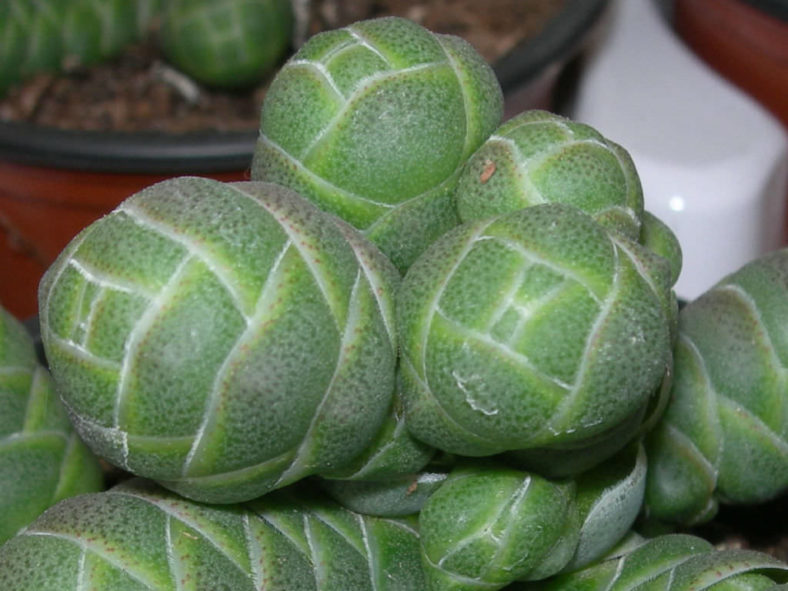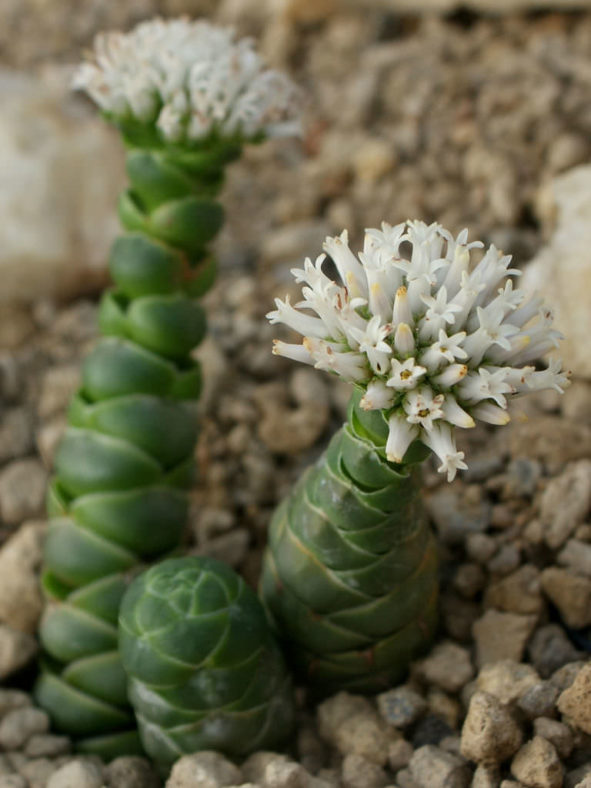Scientific Name
Crassula barklyi N.E.Br.
Common Name(s)
Rattlesnake Buttons, Rattlesnake Crassula, Rattlesnake Tail, Bandaged Finger
Synonym(s)
Crassula teres, Tetraphyle barklyi
Scientific Classification
Family: Crassulaceae
Subfamily: Crassuloideae
Genus: Crassula
Etymology
The specific epithet "barklyi" (pronounced "BARK-lee") honors Sir Henry Barkly (1815-1898), a British politician, colonial governor, and patron of the sciences, who discovered this species in Little Namaqualand.
Origin
The native range of Crassula barklyi extends from near Port Nolloth to near Van Rhynsdorp in the southwestern parts of the Northern Cape province of South Africa. It grows on gentle slopes, usually covered with quartzite gravel, rarely associated with larger rocks or rock outcrops.
Description
Crassula barklyi is a dwarf, compact succulent with erect or rarely decumbent branches covered by overlapping leaves, forming short, almost cylindrical columns. It slowly grows and can reach a height of 4 inches (10 cm) tall, branching around the base or lower parts of stems. The younger branches are almost spherical and look like grey-green rosebuds. The leaves are green to brownish-green with white, membranous, densely ciliate margins. They are thick, fleshy, and saucer-like, measuring up to 0.2 inches (0.5 cm) in length and 0.6 inches (1.5 cm) in width.
The flowers are tiny, stemless, cream-colored, and appear in dense, rounded terminal clusters embedded among leaves in winter.
Hybrids

Hardiness
USDA hardiness zones 9a to 11b: from 20°F (-6.7°C) to 50°F (10°C).
How to Grow and Care
Crassulas are easy to grow but susceptible to mealybugs and fungal diseases. As with all succulents, overwatering is sure to be fatal, so err on the side of too dry rather than too wet. Never let your plant sit in water. If you water from beneath by allowing the plant to sit in a saucer of water, ensure to pour off any excess water after a few minutes.
These succulents are generally started by division, offsets, or leaf cuttings. Crassulas can be easily propagated from a single leaf. Sprout leaves by placing them into a potting mix for succulents, then cover the dish until they sprout.
Repot as needed, preferably during the warm season. To repot your Crassula, ensure the soil is dry before repotting, then gently remove the pot. Gently remove the old soil from the roots, discarding any rotted or dead roots. Treat any cuts with a fungicide. Place the plant in its new pot and backfill it with potting soil, spreading the roots as you repot. Leave the plant dry for a week or so, then begin to water lightly to reduce the risk of root rot.
Learn more at How to Grow and Care for Crassula.
Links
- Back to genus Crassula
- Succupedia: Browse succulents by Scientific Name, Common Name, Genus, Family, USDA Hardiness Zone, Origin, or cacti by Genus
Photo Gallery
Click on a photo to see a larger version.

